Coursera TensorFlow 基础课程-week3
Posted fansy1990
tags:
篇首语:本文由小常识网(cha138.com)小编为大家整理,主要介绍了Coursera TensorFlow 基础课程-week3相关的知识,希望对你有一定的参考价值。
Enhancing Vision with Convolutional Neural Networks
参考:Ubuntu 16 安装TensorFlow及Jupyter notebook 安装TensorFlow。
本篇博客翻译来自 Introduction to TensorFlow for Artificial Intelligence, Machine Learning, and Deep Learning
仅供学习、交流等非盈利性质使用!!!
其他相关文章
Coursera TensorFlow 基础课程-week4
Coursera TensorFlow 基础课程-week3
Coursera TensorFlow 基础课程-week2
Coursera TensorFlow 基础课程-week1
文章目录
1. convolutions and pooling (卷积和池化)
在进行图像处理的过程中,经常会使用滤波器矩阵(Filter)来对原始图片进行处理,而这个过程就是卷积(convolutions)。
如下图所示:
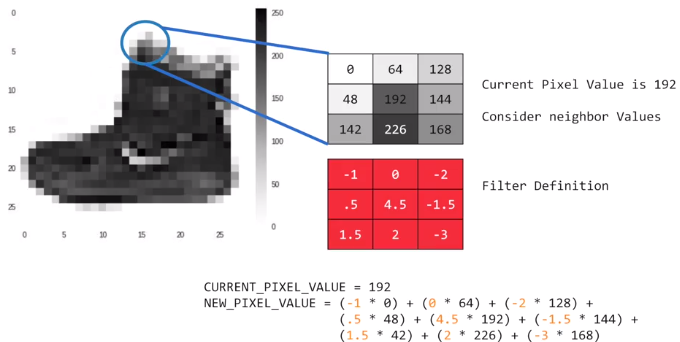
在上图中,针对其中的一个像素点,应用滤波器矩阵(图中给出的矩阵是随机定义的一个矩阵),那么卷积就是针对每个像素点,考虑其上下左右、左上下、右上下的邻居像素点,和滤波器矩阵对应点相乘得到新的像素点,这个转换过程就叫做卷积。
应用卷积可以具有特殊意义,如下两个图:

应用滤波器,可以把纵向特征明显化(即垂直特征明显);

而应用这个滤波器,则可以把横向特征明显化(即水平特征明显);
关于图像的卷积意义,推荐这篇博客: 理解图像卷积操作的意义
池化:简单理解,就是图片的压缩,即把原始比如128*128像素的图片压缩成28*28的图片。
一个简单的例子,如下图:
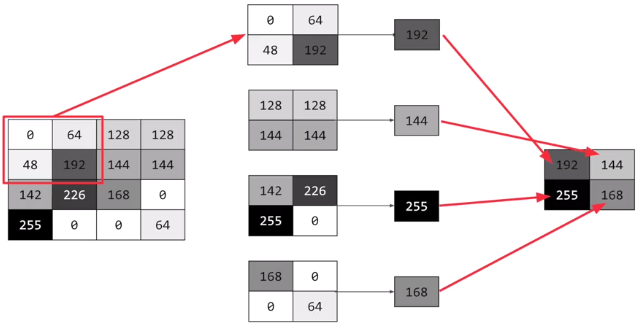
在图中,一个4*4像素的图片,被压缩为2*2的图片。其做法是:每次处理4个像素,找到其最大的像素进行返回。当然这只是其中的一种池化方法,你也可以针对4个像素进行求均值然后返回也可以。
2.实现卷积和池化
之前的代码:
model = tf.keras.models.Sequential([
tf.keras.layers.Flatten(),
tf.keras.layers.Dense(128, activation=tf.nn.relu),
tf.keras.layers.Dense(10, activation=tf.nn.softmax)])
在这个代码基础上,如何修改,可以添加卷积和池化层呢?
如下代码所示:
model = tf.keras.models.Sequential([
tf.keras.layers.Conv2D(64,(3,3), activation='relu',input_shape=(28,28,1)),
tf.keras.layers.MaxPooling2D(2,2),
tf.keras.layers.Conv2D(64,(3,3),activation='relu'),
tf.keras.layers.MaxPooling2D(2,2),
tf.keras.layers.Flatten(),
tf.keras.layers.Dense(128, activation=tf.nn.relu),
tf.keras.layers.Dense(10, activation=tf.nn.softmax)
])
从代码中可看成:
- 最后三行是和之前一样的;
- 第二行,定义了一个卷积层(Conv2D),这个卷积层有64个滤波器矩阵,每个矩阵是一个3*3的矩阵,activation是relu(会丢弃负值),而input_shape中的值是(28,28,1),前面的28,28是图片的大小,而最后一个代表的是像素点的值,即图片是灰度图;
- 第二行的卷积层中的64个滤波器矩阵里面的值,最开始是随机的,随着训练的推进,这些值会被改变,而改变的方向则是使得最终预测效果较好的方向。
- 第三行是一个池化层,MaxPooling意味着最大值保留,同时池化的大小是(2,2),那么一次会处理4个像素点;
- 第四、五行继续添加了一个卷积层和池化层;
- 当一个图片经过2个卷积、池化层后,即叨叨Flatten时,图片会被缩小;
- 缩小的图片,其实指的是对于目标变量更有话语权的特征被筛选出来;
通过下面的代码可以查看构造的模型:
model.summary()
那么,上面构造的模型的summary是什么呢?如下所示:
_________________________________________________________________
Layer (type) Output Shape Param #
=================================================================
conv2d (Conv2D) (None, 26, 26, 64) 640
_________________________________________________________________
max_pooling2d (MaxPooling2D) (None, 13, 13, 64) 0
_________________________________________________________________
conv2d_1 (Conv2D) (None, 11, 11, 64) 36928
_________________________________________________________________
max_pooling2d_1 (MaxPooling2 (None, 5, 5, 64) 0
_________________________________________________________________
flatten (Flatten) (None, 1600) 0
_________________________________________________________________
dense (Dense) (None, 128) 204928
_________________________________________________________________
dense_1 (Dense) (None, 10) 1290
=================================================================
Total params: 243,786
Trainable params: 243,786
Non-trainable params: 0
从上面的数据结果可以看出:
- 第一层卷积输出的大小是26*26*64 ,这是什么意思呢?
首先,一个28*28的图片数据经过卷积层的滤波器矩阵后,其图片变为26*26的大小。由于滤波器大小是3*3,所以原始28*28的图像的最外面的一圈像素点是不能被计算的。这样上下左右就会各少一个像素点,所以得到的是26*26的图片。

所以,如果滤波器是5*5,那么输出是多少呢? (应该是24*24,会少4个像素点)。
其次,64代表64个滤波器,那么一个图片就会输出64个新的图片。
- 第一个池化层,由于其大小是2*2,所以会把4个像素点变成一个,所以26*26的像素点,会变成13*13。
- 第二个卷积层是类似的,像素会减小2,所以是11*11.
- 第二个池化层,会把输入像素减半,即变成5*5 。
- Flatten层的输入为什么是1600? 1600 = 5*5*64,即把64个子图的所有像素点展平,作为Flatten的输入。
3. 使用卷积优化Fashion Mnist数据识别模型
之前的训练代码:
import tensorflow as tf
mnist = tf.keras.datasets.fashion_mnist
(training_images, training_labels), (test_images, test_labels) = mnist.load_data()
training_images=training_images / 255.0
test_images=test_images / 255.0
model = tf.keras.models.Sequential([
tf.keras.layers.Flatten(),
tf.keras.layers.Dense(128, activation=tf.nn.relu),
tf.keras.layers.Dense(10, activation=tf.nn.softmax)
])
model.compile(optimizer='adam', loss='sparse_categorical_crossentropy', metrics=['accuracy'])
model.fit(training_images, training_labels, epochs=5)
test_loss = model.evaluate(test_images, test_labels)
执行完成后,可以得到训练集和测试集的误差及正确率,如下:
Epoch 1/5
60000/60000 [==============================] - 20s 340us/sample - loss: 0.4971 - acc: 0.8251
Epoch 2/5
60000/60000 [==============================] - 18s 306us/sample - loss: 0.3769 - acc: 0.8643
Epoch 3/5
60000/60000 [==============================] - 18s 292us/sample - loss: 0.3389 - acc: 0.8759
Epoch 4/5
60000/60000 [==============================] - 17s 291us/sample - loss: 0.3154 - acc: 0.8850
Epoch 5/5
60000/60000 [==============================] - 14s 230us/sample - loss: 0.2971 - acc: 0.8921
10000/10000 [==============================] - 2s 151us/sample - loss: 0.3676 - acc: 0.8657
改进后的代码,如下:
import tensorflow as tf
print(tf.__version__)
mnist = tf.keras.datasets.fashion_mnist
(training_images, training_labels), (test_images, test_labels) = mnist.load_data()
training_images=training_images.reshape(60000, 28, 28, 1)
training_images=training_images / 255.0
test_images = test_images.reshape(10000, 28, 28, 1)
test_images=test_images/255.0
model = tf.keras.models.Sequential([
tf.keras.layers.Conv2D(64, (3,3), activation='relu', input_shape=(28, 28, 1)),
tf.keras.layers.MaxPooling2D(2, 2),
tf.keras.layers.Conv2D(64, (3,3), activation='relu'),
tf.keras.layers.MaxPooling2D(2,2),
tf.keras.layers.Flatten(),
tf.keras.layers.Dense(128, activation='relu'),
tf.keras.layers.Dense(10, activation='softmax')
])
model.compile(optimizer='adam', loss='sparse_categorical_crossentropy', metrics=['accuracy'])
model.summary()
model.fit(training_images, training_labels, epochs=5)
test_loss = model.evaluate(test_images, test_labels)
其结果如下:
Epoch 1/5
60000/60000 [==============================] - 216s 4ms/sample - loss: 0.4520 - acc: 0.8356
Epoch 2/5
60000/60000 [==============================] - 196s 3ms/sample - loss: 0.2985 - acc: 0.8904
Epoch 3/5
60000/60000 [==============================] - 208s 3ms/sample - loss: 0.2525 - acc: 0.9070
Epoch 4/5
60000/60000 [==============================] - 211s 4ms/sample - loss: 0.2236 - acc: 0.9172
Epoch 5/5
60000/60000 [==============================] - 201s 3ms/sample - loss: 0.1953 - acc: 0.9265
10000/10000 [==============================] - 9s 935us/sample - loss: 0.2658 - acc: 0.9051
通过上面的代码及其运行情况,可以得到:
- 使用优化后的代码,会比之前的代码运行更慢,因为其会涉及把图片进过两次卷积和池化,并且进行64个图片操作;
- 使用优化后的代码后,明显感觉到其在训练集、验证集的效果会更好。
4. 可视化卷积结果
本节主要是卷积结果的可视化,具体指的是:获取上面的模型,然后同时选择多个图片,以及一个卷积(滤波器矩阵),看模型的四层(第一次卷积、第一次池化、第二次卷积、第二次池化)的输出效果。
先查看 测试数据的部分结果:
print(test_labels[:100])
输出为:
[9 2 1 1 6 1 4 6 5 7 4 5 7 3 4 1 2 4 8 0 2 5 7 9 1 4 6 0 9 3 8 8 3 3 8 0 7
5 7 9 6 1 3 7 6 7 2 1 2 2 4 4 5 8 2 2 8 4 8 0 7 7 8 5 1 1 2 3 9 8 7 0 2 6
2 3 1 2 8 4 1 8 5 9 5 0 3 2 0 6 5 3 6 7 1 8 0 1 4 2]
从上面的结果来看下标为0,23,28的图片都是9,也就是shoes,那么一般情况下,卷积可以针对同一类的图片,能发现其共同的特征,使用下面代码:
#%matplotlib
import matplotlib.pyplot as plt
f, axarr = plt.subplots(3,4)
FIRST_IMAGE=0 # 第一个图片下标
SECOND_IMAGE=23# 第二个图片下标
THIRD_IMAGE=28# 第三个图片下标
CONVOLUTION_NUMBER = 1 # 第1个卷积 ,调整卷积为1,2,6 ,可以看到不同图片
from tensorflow.keras import models
layer_outputs = [layer.output for layer in model.layers]
activation_model = tf.keras.models.Model(inputs = model.input, outputs = layer_outputs)
for x in range(0,4):
f1 = activation_model.predict(test_images[FIRST_IMAGE].reshape(1, 28, 28, 1))[x]
axarr[0,x].imshow(f1[0, : , :, CONVOLUTION_NUMBER], cmap='inferno')
axarr[0,x].grid(False)
f2 = activation_model.predict(test_images[SECOND_IMAGE].reshape(1, 28, 28, 1))[x]
axarr[1,x].imshow(f2[0, : , :, CONVOLUTION_NUMBER], cmap='inferno')
axarr[1,x].grid(False)
f3 = activation_model.predict(test_images[THIRD_IMAGE].reshape(1, 28, 28, 1))[x]
axarr[2,x].imshow(f3[0, : , :, CONVOLUTION_NUMBER], cmap='inferno')
axarr[2,x].grid(False)
调整 CONVOLUTION_NUMBER分别为1,2,6,即可看到如下所示图片:
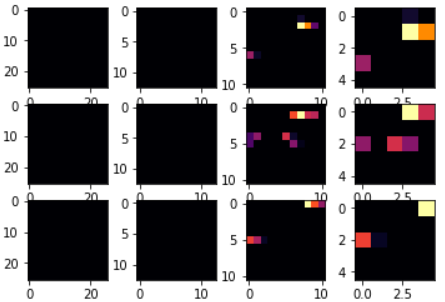
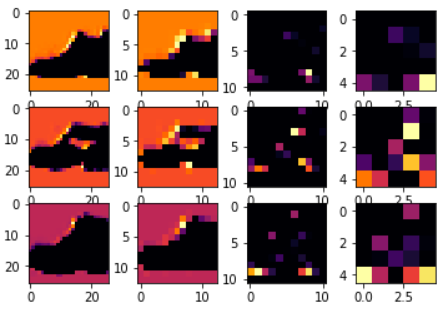
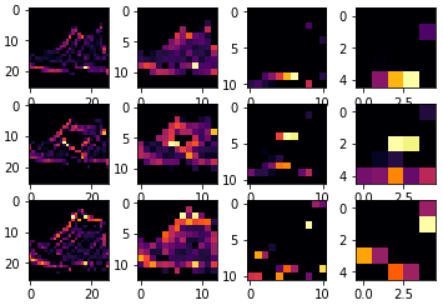
从图片中可以看到:
- 图片像素从最开始的28*28,变为26*26, -> 13*13 , -> 11*11 ,-> 5*5;
- 明显可以看出当CONVOLUTION_NUMBER为2时,其特征区分的最好(就3个对比来说);
使用CONVOLUTION_NUMBER为2,并且调整第二个图片的下标为2,那么可以得到如下图:
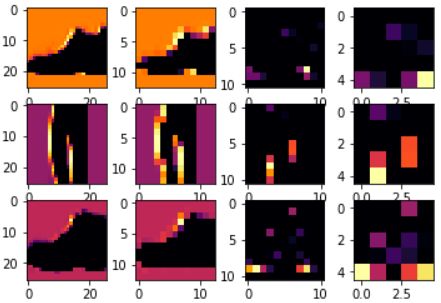
从图上可以看出,使用CONVOLUTION_NUMBER为2的滤波器矩阵,对图片的分类效果比较好,能较明显的区分鞋子和裤子。
5. 纯Python理解卷积和池化
使用如下代码,引入图片:
#%matplotlib
import cv2
import numpy as np
from scipy import misc
i = misc.ascent()
import matplotlib.pyplot as plt
plt.grid(False)
plt.gray()
plt.axis('off')
plt.imshow(i)
plt.show()
图片如下:
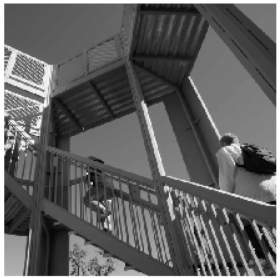
获取图片大小:
i_transformed = np.copy(i)
size_x = i_transformed.shape[0]
size_y = i_transformed.shape[1]
定义3*3 filter:
# This filter detects edges nicely
# It creates a convolution that only passes through sharp edges and straight
# lines.
#Experiment with different values for fun effects.
#filter = [ [0, 1, 0], [1, -4, 1], [0, 1, 0]]
# A couple more filters to try for fun!
filter = [ [-1, -2, -1], [0, 0, 0], [1, 2, 1]]
#filter = [ [-1, 0, 1], [-2, 0, 2], [-1, 0, 1]]
# If all the digits in the filter don't add up to 0 or 1, you
# should probably do a weight to get it to do so
# so, for example, if your weights are 1,1,1 1,2,1 1,1,1
# They add up to 10, so you would set a weight of .1 if you want to normalize them
weight = 1
应用卷积:
for x in range(1,size_x-1):
for y in range(1,size_y-1):
convolution = 0.0
convolution = convolution + (i[x - 1, y-1] * filter[0][0])
convolution = convolution + (i[x, y-1] * filter[0][1])
convolution = convolution + (i[x + 1, y-1] * filter[0][2])
convolution = convolution + (i[x-1, y] * filter[1][0])
convolution = convolution + (i[x, y] * filter[1][1])
convolution = convolution + (i[x+1, y] * filter[1][2])
convolution = convolution + (i[x-1, y+1] * filter[2][0])
convolution = convolution + (i[x, y+1] * filter[2][1])
convolution = convolution + (i[x+1, y+1] * filter[2][2])
convolution = convolution * weight
if(convolution<0):
convolution=0
if(convolution>255):
convolution=255
i_transformed[x, y] = convolution
查看卷积后的结果:
# Plot the image. Note the size of the axes -- they are 512 by 512
plt.gray()
plt.grid(False)
plt.imshow(i_transformed)
#plt.axis('off')
plt.show()
得到的图如下:

应用池化:
new_x = int(size_x/2)
new_y = int(size_y/2)
newImage = np.zeros((new_x, new_y))
for x in range(0, size_x, 2):
for y in range(0, size_y, 2):
pixels = []
pixels.append(i_transformed[x, y])
pixels.append(i_transformed[x+1, y])
pixels.append(i_transformed[x, y+1])
pixels.append(i_transformed[x+1, y+1])
pixels.sort(reverse=True)
newImage[int(x/2),int(y/2)] = pixels[0]
# Plot the image. Note the size of the axes -- now 256 pixels instead of 512
plt.gray()
plt.grid(False)
plt.imshow(newImage)
#plt.axis('off')
plt.show()
查看结果:
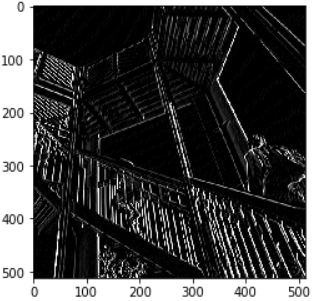
从结果可以看出,图片的一些特征是被强化的。
6. 测验:
- 第 1 个问题
What is a Convolution?
- a. A technique to filter out unwanted images
- b. A technique to make images bigger
- c. A technique to make images smaller
- d. A technique to isolate features in images
- 第 2 个问题
What is a Pooling?
- a. A technique to isolate features in images
- b. A technique to combine pictures
- c. A technique to reduce the information in an image while maintaining features
- d. A technique to make images sharper
- 第 3 个问题
How do Convolutions improve image recognition?
- a. They make the image smaller
- b. They make processing of images faster
- c. They make the image clearer
- d. They isolate features in images
- 第 4 个问题
After passing a 3x3 filter over a 28x28 image, how big will the output be?
- a. 28x28
- b. 25x25
- c. 26x26
- d. 31x31
- 第 5 个问题
After max pooling a 26x26 image with a 2x2 filter, how big will the output be?
- a. 26x26
- b. 28x28
- c. 13x13
- d. 56x56
- 第 6 个问题
Applying Convolutions on top of our Deep neural network will make training:
- a. It depends on many factors. It might make your training faster or slower, and a poorly designed Convolutional layer may even be less efficient than a plain DNN!
- b. Stay the same
- c. Faster
- d. Slower
My Guess:
1. d
2. c
3. d
4.c
5. c
6. a
7. 额外练习:
针对MNIST数据构建的模型进行优化,同时满足如下要求:
- 提升正确率到99.8%+;
- 只能使用一个卷积层和一个池化层;
- 当达到99.8%+的正确率后,立即停止训练(正常情况下20步骤内可以达到),并打印Reached 99.8% accuracy so cancelling training!;
下面是提示代码:
import tensorflow as tf
# YOUR CODE STARTS HERE
# YOUR CODE ENDS HERE
mnist = tf.keras.datasets.mnist
(training_images, training_labels), (test_images, test_labels) = mnist.load_data()
# YOUR CODE STARTS HERE
# YOUR CODE ENDS HERE
model = tf.keras.models.Sequential([
# YOUR CODE STARTS HERE
# YOUR CODE ENDS HERE
])
# YOUR CODE STARTS HERE
# YOUR CODE ENDS HERE
Code Download Here
以上是关于Coursera TensorFlow 基础课程-week3的主要内容,如果未能解决你的问题,请参考以下文章